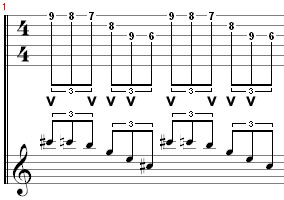Difference between revisions of "Rest-stroke"
Admin wiki (talk | contribs) |
Admin wiki (talk | contribs) |
||
| Line 60: | Line 60: | ||
{|width="100%" align="center" | {|width="100%" align="center" | ||
| − | | width="300" |[[ | + | | width="300" |[[File:V-v-v-ex.jpg]] |
|{{#widget:Daily_Motion|id=xfbdc6_butee-v-v-v_music}} | |{{#widget:Daily_Motion|id=xfbdc6_butee-v-v-v_music}} | ||
|} | |} | ||
Revision as of 19:41, 15 December 2012
Rest-stroke is the most important typically-Manouche picking technique used for choruses and solos. One string is plucked downwards and the pick ends its run on the next string excepted in the case when the upper E string is played. This movement is at the very base of Manouche sound and it therefore has to be worked out and be played effortlessly (though it may look simple at first glance).
Contents
Rest-stroke examples
Two different viewpoints and another example playing with volumes of rest-stroke.
Rest-stroke exercises
The rest-stroke technique is essential in Gypsy guitar and therefore it is very important to master it as mush as possible. The advantage of this technique est that the stroke is moving downward (as in downstroke) which enables to ally the power of the wrist rotation with the weight of the hand. The volume gained is then noticeable, and allows a solist playing as loud as other instruments naturally louder such as the violin ou several guitars together for the accompaniment. Despite the fact that this technique often requires several consecutive downstrokes (2 or 3), with practice, it is possible to play accurately at very fast tempos (triplets at 230 bpm or sixteenths at 160 bpm for the Rosenberg). To gain speed with the rest-stroke technique, there are no real secrets: work, work and work. There are ways though that allow saving time by optimizing the personal work. One way is to take advantage of the bounce on the string on which the pick rests, to strike again the string above faster. In order to make it easier, there is a specific position of the wrist. Also, in order to gain volume, it is important that the thumb remains straight on the picks. The thumb knuckle must not be folded. Here are a few exercises to practice the position, the rest-stroke and the bounce.
Rest-stroke 4 times in a row on each open string
Downwards and upwards. Here, the right arm is not too much involved in the rest-stroke, it only moves to position the hand while changing string (this is Stochelo's technique: the strength and the speed of the rest-stroke come from the wrist). Do this exercise as fast as possible without slowing down, and without losing accuracy.
V-^-V on each open string upwards then downwards
This example depicts the difference in doing the rest-stroke while changing string upwards (wrist movement) or downwards (arm weight).
Scale played solely in rest-strokes
Do this exercise on any scale you like, still as fast as possible without slowing down nor glitches. The gesture must be regular, accurate and as loud as possible.
Rest Stroke in -v-v-
A v-v exercise
On just one string. The return on the A string is done by bouncing on the high E string.
Another v-v exercise
on two adjacent strings that illustrates the difficulty to overcome when changing strings. Here, the return on the A string from the high E string cannot benefit from the bounce effect (since there is no string under the high E duh). The return is only done out of the wrist muscles and tonicity. The arm does not move excepted to change string. Note that changing string from A to high E (downwards) is done with the weight of the arm as stated previously. With time and practice, you should be able to do this exercise with the forearm completely relaxed: this is the target to reach.
on each open string and downwards.
v-v-v on three strings upwards
That's the best part of this page! Still played with rest-strokes, three times in a row, while changing string upwards. This is probably one of the toughest movements and hardest to play fast. Here the notes are the following:

|




